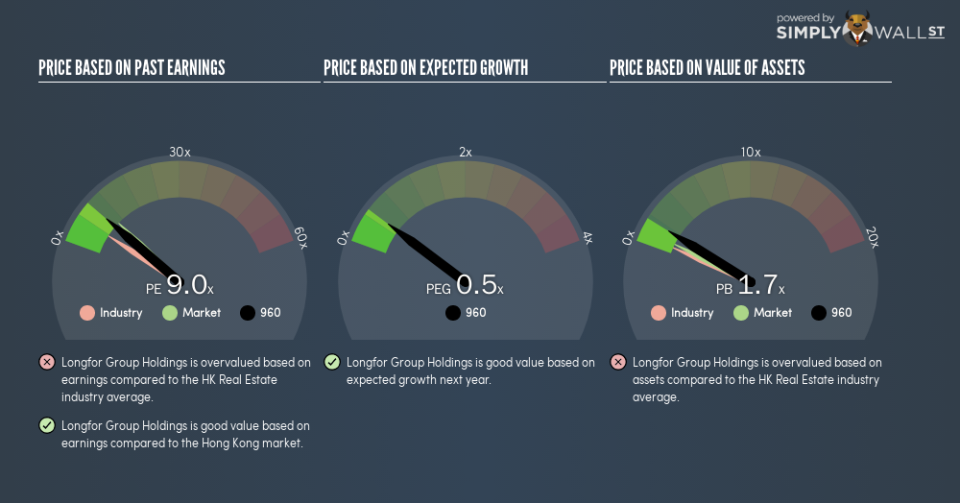Should You Be Tempted To Sell Longfor Group Holdings Limited (HKG:960) Because Of Its P/E Ratio?

Want to participate in a short research study? Help shape the future of investing tools and receive a $60 prize!
The goal of this article is to teach you how to use price to earnings ratios (P/E ratios). We’ll show how you can use Longfor Group Holdings Limited’s (HKG:960) P/E ratio to inform your assessment of the investment opportunity. Longfor Group Holdings has a P/E ratio of 8.99, based on the last twelve months. That is equivalent to an earnings yield of about 11%.
Check out our latest analysis for Longfor Group Holdings
How Do You Calculate Longfor Group Holdings’s P/E Ratio?
The formula for price to earnings is:
Price to Earnings Ratio = Price per Share (in the reporting currency) ÷ Earnings per Share (EPS)
Or for Longfor Group Holdings:
P/E of 8.99 = CN¥21.01 (Note: this is the share price in the reporting currency, namely, CNY ) ÷ CN¥2.34 (Based on the trailing twelve months to June 2018.)
Is A High P/E Ratio Good?
A higher P/E ratio means that investors are paying a higher price for each HK$1 of company earnings. All else being equal, it’s better to pay a low price — but as Warren Buffett said, ‘It’s far better to buy a wonderful company at a fair price than a fair company at a wonderful price.’
How Growth Rates Impact P/E Ratios
P/E ratios primarily reflect market expectations around earnings growth rates. When earnings grow, the ‘E’ increases, over time. That means even if the current P/E is high, it will reduce over time if the share price stays flat. So while a stock may look expensive based on past earnings, it could be cheap based on future earnings.
It’s nice to see that Longfor Group Holdings grew EPS by a stonking 38% in the last year. And earnings per share have improved by 9.8% annually, over the last five years. I’d therefore be a little surprised if its P/E ratio was not relatively high.
How Does Longfor Group Holdings’s P/E Ratio Compare To Its Peers?
The P/E ratio indicates whether the market has higher or lower expectations of a company. As you can see below, Longfor Group Holdings has a higher P/E than the average company (5.7) in the real estate industry.
Its relatively high P/E ratio indicates that Longfor Group Holdings shareholders think it will perform better than other companies in its industry classification. Shareholders are clearly optimistic, but the future is always uncertain. So investors should delve deeper. I like to check if company insiders have been buying or selling.
A Limitation: P/E Ratios Ignore Debt and Cash In The Bank
The ‘Price’ in P/E reflects the market capitalization of the company. In other words, it does not consider any debt or cash that the company may have on the balance sheet. In theory, a company can lower its future P/E ratio by using cash or debt to invest in growth.
Spending on growth might be good or bad a few years later, but the point is that the P/E ratio does not account for the option (or lack thereof).
How Does Longfor Group Holdings’s Debt Impact Its P/E Ratio?
Longfor Group Holdings has net debt worth 79% of its market capitalization. If you want to compare its P/E ratio to other companies, you should absolutely keep in mind it has significant borrowings.
The Bottom Line On Longfor Group Holdings’s P/E Ratio
Longfor Group Holdings’s P/E is 9 which is below average (10.4) in the HK market. The company may have significant debt, but EPS growth was good last year. If it continues to grow, then the current low P/E may prove to be unjustified.
Investors should be looking to buy stocks that the market is wrong about. If it is underestimating a company, investors can make money by buying and holding the shares until the market corrects itself. So this free visualization of the analyst consensus on future earnings could help you make the right decision about whether to buy, sell, or hold.
You might be able to find a better buy than Longfor Group Holdings. If you want a selection of possible winners, check out this free list of interesting companies that trade on a P/E below 20 (but have proven they can grow earnings).
To help readers see past the short term volatility of the financial market, we aim to bring you a long-term focused research analysis purely driven by fundamental data. Note that our analysis does not factor in the latest price-sensitive company announcements.
The author is an independent contributor and at the time of publication had no position in the stocks mentioned. For errors that warrant correction please contact the editor at editorial-team@simplywallst.com.

